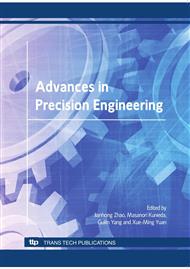[1]
L. Ma, C. Gao, Z. Mao, J. Zhou, J. Shen, X. Hu, et al.: Collagen/chitosan porous scaffolds with improved biostability for skin tissue engineering. Biomaterials, Vol. 24(26) (2003), pp.4833-4841.
DOI: 10.1016/s0142-9612(03)00374-0
Google Scholar
[2]
N. L'Heureux, N. Dusserre, G. Konig, B. Victor, P. Keire, T. N. Wight, et al.: Human tissue-engineered blood vessels for adult arterial revascularization. Nature Medicine, Vol. 12(3) (2006), pp.361-365.
DOI: 10.1038/nm1364
Google Scholar
[3]
S. Y. Chew, R. Mi, A. Hoke, and K. W. Leong: Aligned protein-polymer composite fibers enhance nerve regeneration: A potential tissue-engineering platform. Advanced Functional Materials, Vol. 17(8) (2007), pp.1288-1296.
DOI: 10.1002/adfm.200600441
Google Scholar
[4]
C. K. Chua, K. F. Leong, K. H. Tan, F. E. Wiria, and C. M. Cheah: Development of tissue scaffolds using selective laser sintering of polyvinyl alcohol/hydroxyapatite biocomposite for craniofacial and joint defects. Journal of Materials Science: Materials in Medicine, Vol. 15(10) (2004).
DOI: 10.1023/b:jmsm.0000046393.81449.a5
Google Scholar
[5]
R. L. Simpson, F. E. Wiria, A. A. Amis, C. K. Chua, K. F. Leong, U. N. Hansen, et al.: Development of a 95/5 poly(L-lactide-co-glycolide)/hydroxylapatite and β-tricalcium phosphate scaffold as bone replacement material via selective laser sintering. Journal of Biomedical Materials Research - Part B Applied Biomaterials, Vol. 84(1) (2008).
DOI: 10.1002/jbm.b.30839
Google Scholar
[6]
K. F. Leong, C. K. Chua, N. Sudarmadji, and W. Y. Yeong: Engineering functionally graded tissue engineering scaffolds. Journal of the Mechanical Behavior of Biomedical Materials, Vol. 1(2) (2008), pp.140-152.
DOI: 10.1016/j.jmbbm.2007.11.002
Google Scholar
[7]
C. K. Chua, N. Sudarmadji and K. F. Leong. Process Flow for Designing Functionally Graded Tissue Engineering Scaffolds. in Proceedings of the 4th International Conference on Advanced Research in Virtual and Rapid Prototyping: Innovative Developments in Design and Manufacturing Advanced Research in Virtual and Rapid Prototyping 2009. pp.45-49.
DOI: 10.1201/9780203859476.ch6
Google Scholar
[8]
D. Deng, W. Liu, F. Xu, Y. Yang, G. Zhou, W. J. Zhang, et al.: Engineering human neo-tendon tissue in vitro with human dermal fibroblasts under static mechanical strain. Biomaterials, Vol. 30(35) (2009), pp.6724-6730.
DOI: 10.1016/j.biomaterials.2009.08.054
Google Scholar
[9]
Y. Liu, H. S. Ramanath and D. A. Wang: Tendon tissue engineering using scaffold enhancing strategies. Trends in Biotechnology, Vol. 26(4) (2008), pp.201-209.
DOI: 10.1016/j.tibtech.2008.01.003
Google Scholar
[10]
C. K. Chua, J. An and K. F. Leong. Spinning of Biomaterial Microfibers for Tendon Tissue Engineering. in Proceedings of the 4th International Conference on Advanced Research in Virtual and Rapid Prototyping: Innovative Developments in Design and Manufacturing Advanced Research in Virtual and Rapid Prototyping 2009. pp.31-35.
DOI: 10.1201/9780203859476.ch4
Google Scholar
[11]
J. L. Ricci, A. G. Gona, H. Alexander, and J. R. Parsons: Morphological characteristics of tendon cells cultured on synthetic fibers. Journal of Biomedical Materials Research, Vol. 18(9) (1984), pp.1073-1087.
DOI: 10.1002/jbm.820180910
Google Scholar
[12]
C. M. Hwang, Y. Park, J. Y. Park, K. Lee, K. Sun, A. Khademhosseini, et al.: Controlled cellular orientation on PLGA microfibers with defined diameters. Biomedical Microdevices, (2009), pp.1-8.
DOI: 10.1007/s10544-009-9287-7
Google Scholar
[13]
Q. P. Pham, U. Sharma and A. G. Mikos: Electrospinning of polymeric nanofibers for tissue engineering applications: A review. Tissue Engineering, Vol. 12(5) (2006), pp.1197-1211.
DOI: 10.1089/ten.2006.12.1197
Google Scholar
[14]
T. J. Sill and H. A. von Recum: Electrospinning: Applications in drug delivery and tissue engineering. Biomaterials, Vol. 29(13) (2008), p.1989-(2006).
DOI: 10.1016/j.biomaterials.2008.01.011
Google Scholar
[15]
M. R. Williamson and A. G. A. Coombes: Gravity spinning of polycaprolactone fibres for applications in tissue engineering. Biomaterials, Vol. 25(3) (2004), pp.459-465.
DOI: 10.1016/s0142-9612(03)00536-2
Google Scholar
[16]
C. M. Hwang, A. Khademhosseini, Y. Park, K. Sun, and S. H. Lee: Microfluidic chip-based fabrication of PLGA microfiber scaffolds for tissue engineering. Langmuir, Vol. 24(13) (2008), pp.6845-6851.
DOI: 10.1021/la800253b
Google Scholar


